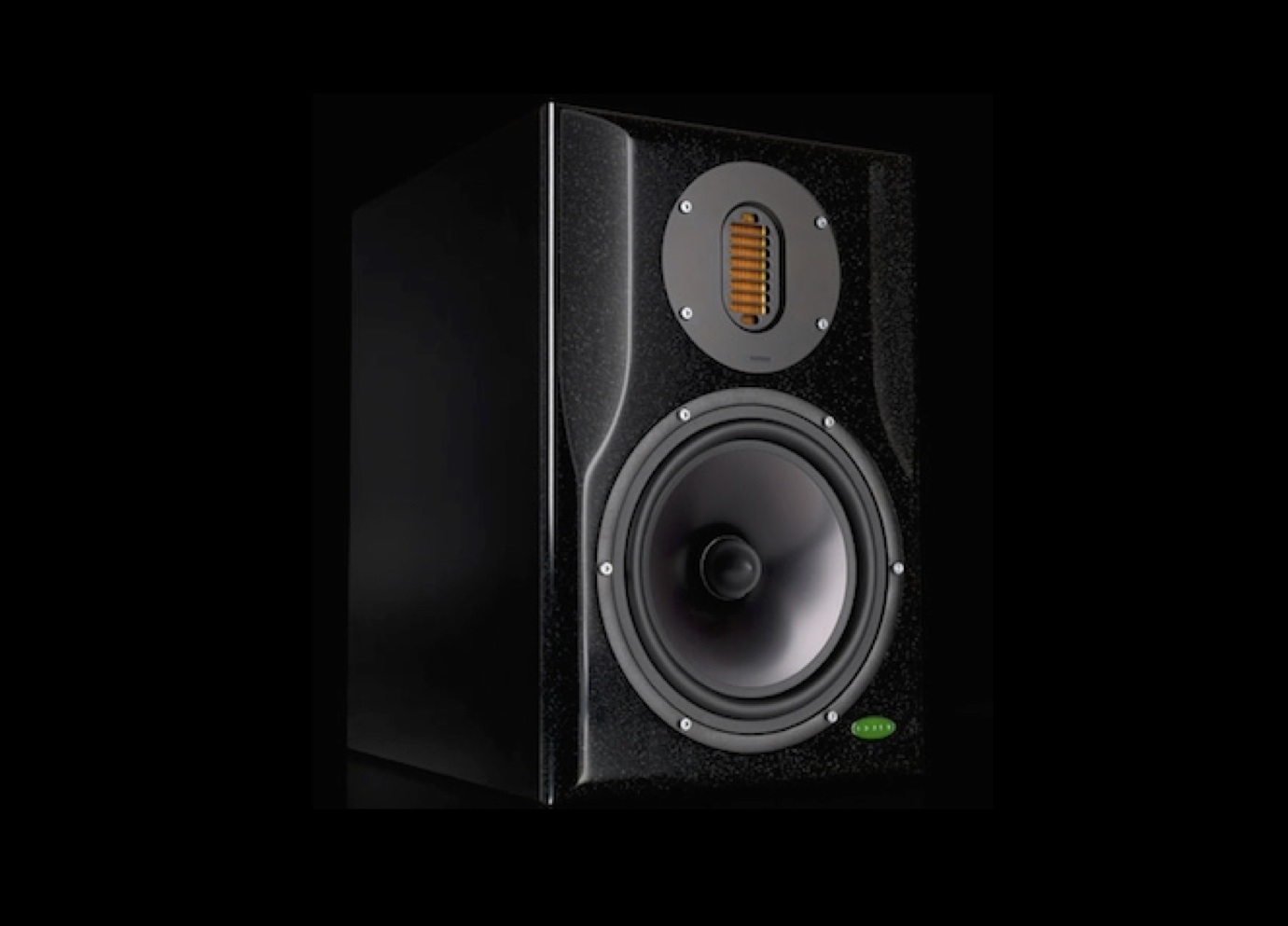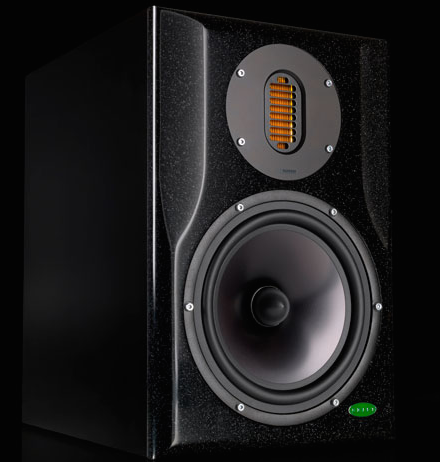New Gear Review: Unity Audio Super Rock Active Monitors

The front panel of the Unity Super Rock is made of Corian®, a material often used for high-end kitchen countertops.
Unity Audio has made some serious fans in the pro audio realm over the past few years. Their initial offering to the world of studio monitors was the original “Rock” series monitors, which has since been replaced by The Rock MkII, a sealed 2-way monitor with a 6” woofer and a ribbon tweeter.
The Rock MkII series has been a huge hit among discerning engineers, often lauded for its accuracy. Since then, Unity Audio has expanded its product line to include several smaller monitors, as well as larger models such as The 3-way “Boulder” (expandable to 4-way with the B.A.B.E. Cabinet), and even a larger sub called The Avalanche. Thematically and sonically, that takes us through most of the entire range.
However, some engineers don’t have space in their room or their bank account for the larger models, but may still want a 2-way model with a little more happening in the low register. Enter the newest offering: The Super Rock. Effectively starting with The Rock as a blueprint, and then expanding or improving every spec, The Super Rock aims to tap directly into that need for a full-range, 2-way design.
Features
Unboxing the unit is a simple affair, as all that’s included in the box is the speaker, IEC cable, and a product registration form. Truth be told, I’m fine with this simplicity. It’s a professional grade tool, and as such it doesn’t have to emerge from a lotus flower, or rise up out of the packing peanuts on a clamshell.
The monitor itself is also of deceptively simple design; there are no parameters to tweak, apart from input level. Many monitors have included dip switches, adjustable crossovers and various shelving or tilt equalizers to fine tune the monitor to your surroundings. Unity Audio has made a purposeful decision to listen, tweak, and obtain what they believe is the best possible performance out of a set design, leaving nothing to chance and no way for armchair acousticians to wreck the intended outcome. Some engineers may like this and others not so much. This firmly puts The Super Rock into the category of “yea or nay”, and in some ways that is preferable.
Truth be told, acoustic issues are often better handled by room treatment, and more circuitry in your path can mean more noise and more potential for problems. The rear panel contains a balanced +4dBu XLR input and unbalanced -10dBV RCA input.
Unity Audio describes The Super Rock as “The Rock on steroids,” and by all accounts that seems to be true. The cabinet is big and heavy, measuring in at 16”H x 10.5”W x 13.9”D and weighing 30 pounds each. You will need some decent stands or a solid meter bridge to support these.
Much of the weight comes from the solid 30mm Corian® front baffle, affixed to an 18mm birch plywood cabinet… no MDF here! Corian® (often used in kitchen countertops) is non-porous, non-resonant, repairable and seamless. The weight and one-piece design ensures that energy is translated to the driver and subsequent room, in lieu of the cabinet itself. Additionally, the edges have been machined and shaped to minimize HF diffraction. Corian® behaves somewhat similarly to stone, and picking it up will verify that The Super Rock is not just a name.
The original woofer of The Rock has been expanded from 6” to an 8” (220mm) SEAS aluminum woofer. The tweeter is a Mundorf AMT folded ribbon tweeter, which has a different mechanical operating principle than the more common soft-dome tweeter.
With ribbon tweeters, air is actually squeezed out of the folds of the ribbon as it contracts, and as such, the sound is different comparably. Both drivers have a designated discrete A/B amplifier designed by Tim de Paravicini of EAR (Esoteric Audio Research).
It’s important to note at this time that the cabinet is also un-ported, which is relatively rare amongst modern studio monitor manufacturers. Un-ported cabinets are generally less efficient, have a lower max SPL rating, and tend to not be flat as far down the frequency spectrum as their ported counterparts. (Ports in a loudspeaker allow the cabinet to be “tuned” to a lower note, offering greater bass extension.)
However, un-ported monitors also have some key benefits. All things being equal, ported monitors may offer a lower bottom note in a smaller package, but what happens below that frequency can be unpredictable in all but the highest quality, most expensive designs. Un-ported monitors may roll off the lows at a higher frequency, but the roll-off is much more gradual and smooth.
Also, at certain levels “chuffing” (a very British term to describe audible air movement around the port) can be heard. Additionally, tuning a port to a specific note often leaves drivers ringing past the initial impulse at certain frequencies. In other words, the speaker keeps moving after the signal has ceased; this is not an issue with un-ported monitors.
Many ported monitors also have their ports facing to the rear (so as to not face the port directly at the engineer), which can wreak havoc with nearby boundaries.
I don’t mean to in any way insinuate that un-ported monitors are superior; there is always a trade-off with any design choice. For what it’s worth, the Yamaha NS-10 and the Auratone, two of the most commonly used and popular monitors of all time, feature a sealed cabinet design.
In Use
My current monitor system consists of ADAM A5X mains with a KRK V10 sub, so I’ll be drawing comparisons against that. Please keep in mind this is not really a fair comparison, as The Super Rocks are quite a bit more expensive than the ADAMs, even with the added sub.

The Corian® front panel is affixed to a solid birch plywood cabinet rather than a more cost-effective MDF alternative. No expense spared here!
I placed The Super Rocks on my stands, put on some of my favorite music and dug in to see how they fared. My initial response was underwhelming; there is nothing exciting or hyped about these monitors. It’s actually kind of disconcerting at first, but after a while, it truly begins to sink in that it’s all there… just with nothing extra added.
Even down at lower listening levels, I could feel and hear the low end accurately. What is on display for your ears is exceedingly accurate (unity specs quote +/- 3dB from 35Hz to 38kHz… very respectable).
The frequency response of these monitors should be sufficient for all the most booty-shaking bass tracks, and very few engineers have access to rooms that will be even close to accurate in the sub-bass range. For those that really need to hear extreme lows, consider adding the Avalanche Sub, which gets you down to 22Hz!
The imaging is pinpoint accurate, making panning (which used to feel like more of a guessing game) fun and exciting. Sitting in the sweet spot yields a lovely 3D response. It became easier to place an instrument or voice into a sound field, rather than the feeling of just making it louder or softer.
Mixing music flat out became easier, faster, and translated better to the outside world. Switching to the new system mid-mixes for Brooklyn’s The Bushwick Hotel was a scary proposition, but quickly highlighted issues with effects and clarity. Problems were easier to sort out and previously subtle differences became glaringly obvious. The separation of instruments is outstanding. Distortion in the source was easily detectable, which helped immensely with problem solving and subtle shading and texture.
To Be Critical
As a reviewer, it’s my job to be very critical of any gear that I write about. Readers need to be able to make informed decisions about gear based on this information. In my initial testing, I thought I heard a small amount of hiss coming out of The Super Rocks compared to my ADAMs. In order to determine if this was really the case, I ran multiple tests to see if there was really a noise issue.
By carefully matching the output level of The Super Rocks to my ADAMs, I was able to capture and analyze the noise profile of each monitor. Using a measurement microphone and Izotope Insight, I was able to directly compare the noise from the woofer and the tweeter at high gain and low gain settings.
The results were always within a dB of one another, with each monitor winning two out of the four times I ran the tests. These variations can easily be attributed to ambient noise in my studio or any other number of environmental issues.
Summing it Up
It is my aim is to be fair, thorough and accurate as possible with my critiques. I went to all this trouble so that I can safely say with no reservations that these monitors are phenomenal.
Try as I might, I can find no fault in the construction, execution, imaging or accuracy of The Super Rock series. All in all, I found them to be a joy to work on, and feel they would be a valuable set of monitors at any facility.
At a street price of $2,499 each, they don’t come cheap, but if you are a working engineer, I believe that gear at this level will pay for itself in the long run. In the short run… anyone looking to buy a pair of ported monitors so I can trade up?
Please note: When you buy products through links on this page, we may earn an affiliate commission.






